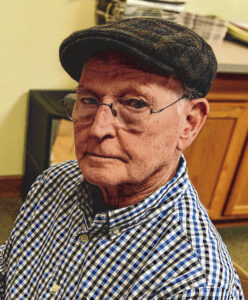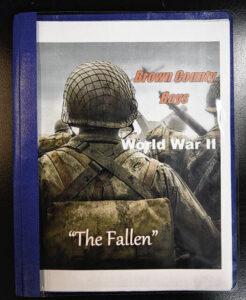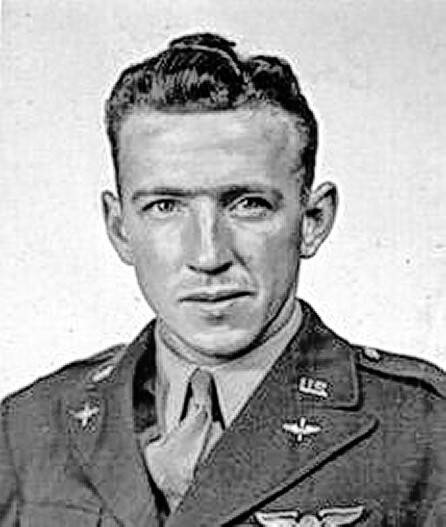By Jim Watkins, guest columnist
The American B-24 Liberator four engine bomber #42-94907 was one of 18,482 built. The plane flew 15 missions in the European theatre of World War II.
The first two missions were on June 6, 1944 in support of the D-Day Normandy landings. The 15th mission was to southern Germany. The navigator for this mission would be Lt. James Bond of Brown County, known to family and friends as “Jimmy.”
Bond was inducted into the U.S. Army on Jan. 7, 1942 — exactly one month after Pearl Harbor. He was 21 and a graduate of Helmsburg High School.
After basic training he would be engaged in a series of training assignments that would last nearly two years.

The first of these assignments sent him to Scott Field in Illinois for radio training and then it was on to Hawaii. After spending eight months there he decided to volunteer for the Army Air Force. This decision meant he transferred to Santa Ana, California to receive his pre-flight training. Las Vegas, Nevada was the next stop for gunnery school and then on to Ellington Field in Texas for what would become his specialty training in advanced navigation. Bond graduated and received his “wings” as a commissioned second lieutenant on Feb. 26. 1944.
In June he was lucky enough to get back to Brown County on furlough and was able to spend valuable time visiting family and friends. In fact, he was home on June 6 when #42-94907 (this bomber had no nickname) was crossing the English Channel on two separate missions in support of the Allied landings in France. After his furlough Bond was assigned overseas duty and sent to Wendling Air Force Base in Norfolk, England.
Bond’s first mission, the 15th for #42-94907, would be July 21. That mission originally had a target just across the English Channel for troop support close to St. Lo, France. Among flight crews a mission as short as this would have the derogatory designation as a “milk run.” But that mission was scrubbed. The new target would take them over the German homeland to Oberpfaffenhofen near Munich, which was no “milk run.”
Officers assembled for the mission briefing at 3:30 a.m. to take in the details and the strategy of the mission. Then breakfast, which was often hardly touched. This mission would be about eight hours in duration totaling some 1,800 miles. Return to base hopefully would be around 2:30 p.m.
Take offs began at 6:05 a.m. Aboard the B-24 bombers waiting in line for their take off were crew members weighed down with anxiety and wearing bulky flight gear that was heavy with perspiration by the time of lift off. Soon enough, as the bomber gained altitude, donning oxygen masks was required.
With a plane that could attain an altitude of some 25,000 feet crews would soon be experiencing temperatures anywhere from 35 to 65 degrees below zero. Actually more men were disabled by frostbite than by combat wounds during the air war. Large openings on either side of the rear fuselage where the waist gunners were positioned allowed a constant torrent of air streaming through the plane. This torrent greatly increased at the most critical time when they were over the target and the bomb doors were opened.
Anti-aircraft installations and German fighter planes were in abundance protecting Oberpfaffenhofen and its aircraft factory.
Over the target at 10:30 a.m. the bombers were set upon by 25 to 30 German Messerschmitt Me-109 fighter planes then #42-94907 was hit and set on fire. Survivor Sgt. Harrison Cuzick, the radio operator, after repatriation described the action.
“We were attacked by enemy fighters just after bombs away. I was trying to get to the flight deck. I was wounded. The navigator, 2nd Lt. James W. Bond, and bombardier 1st Lt. Evan E. Tschudy, were under direct fire. Pilot 2nd Lt. Henry F. Telkin and copilot 2nd Lt. Bonnie R. Puryear were not wounded as far as I know. Telkin gave orders to leave ship. There was fire in the bomb bay. Our oxygen was gone and I was about gone. Our pilot or copilot opened the top hatch. I bailed out. I didn’t see any other chutes. I was unconscious most of the way down. I do remember them shooting at me three times coming down,” he wrote.
Cuzick was hit in both lower legs coming down with worse injuries on his left where all five toes had to be amputated. The remains of three crew members were found by the Germans and placed in three coffins to be buried in the cemetery at Oberschondorf.
The #42-94907 had plummeted out of the sky and crashed into the Ammersee, a large lake west of Munich. Five of the crew members were still aboard, one of whom was Bond. The wounded Sgt. Cuzick was taken prisoner, hospitalized and then served out the war in a prisoners of war camp. Bond and the others were listed as missing. Families were notified while #42-94907 remained at the bottom of the lake.
In late July of 1945, after a year of worry, prayer and hope, Bond’s parents, Earl and Grace Bond, were notified officially that their son had been killed in action.
There is a sad, ironic, happenstance related to #42-94907’s time immersed in the Ammersee that is described in the booklet, “The Bond Family History in Brown County 1860-1993” by family member Jeffrey S. Bond.
One of Jimmy’s brothers, Dale, was part of the Army of Occupation after the German surrender earlier in 1945. Dale and a few friends on a three day pass went to a large lake they had heard about and rented a sail boat. Unknowingly, Dale was sailing on the Ammersee, the very lake where his brother’s wreckage would be found two years later.
“The Bond Family History” can be found at the Brown County Public Library. The wreck of #42-94907 was salvaged in June 1947 and the five crewmen were found inside. Among the personal items found was a gold ring inscribed simply “Bond.”
These five crew members along with the other three previously buried by the Germans were transported to the Jefferson Barracks National Cemetery in St. Louis, Missouri for burial. Jimmy also has a memorial marker at the Round Hill Cemetery in Indianapolis.
Jimmy had three sisters, Betty, Ruth, and Susie; and four brothers, Jack (Army), Dale (Army), Richard and Billy.

The cover of “The Fallen” by Jim Watkins that memorializes Brown County soldiers who never returned home from World War II. “Every fatality of war is a tragic story. The enormity of it nationwide taxes all comprehension, but when narrowed down to a little rural area of middle America one is more able to appreciate the terrible sacrifices made during that time,” Watkins said.
Anyone who wishes to learn more about this period of the war can read “The Wild Blue, The Men and Boys Who Flew the B-24s Over Germany” by Stephen Ambrose. You can also watch the 1948 film “Twelve O’clock High” starring Gregory Peck and Dean Jagger, which is a good and realistic depiction of the air war over Europe although it features B-17s and not B-24s.
Jim Watkins is a Brown County Historical Society member who wrote “The Fallen,” a memorial document about young men from Brown County who never returned home from World War II. Watkins was a public school teacher for 42 years and has always been interested in learning about WWII. He can be reached at [email protected].





